 3D reconstruction of the great "dancing Shiva" of the royal city of Koh Ker (10th century), north of Cambodia.
3D reconstruction of the great "dancing Shiva" of the royal city of Koh Ker (10th century), north of Cambodia. MAINTENANCE. French archaeologist Eric Bourdonneau has just been appointed head of the regional branch of the French School of the Far East (EFEO, see box ) in Cambodia where he directs the excavations of the majestic site of Koh Ker, the former Khmer royal capital of the 10th century. century located in the north of the country. Interview in Siem Reap, in the premises of the institution, with this researcher who has embarked on a struggle for the restitution of looted works.
Why did you become interested in Koh Ker, this ephemeral royal city located 80 km northeast of Angkor?
For two reasons. First of all, because this major site, contemporary with the temples of Angkor, saw the birth in the 10th th century a particular cult dedicated to the Hindu deity Shiva, the "Lord of the Three Worlds". It is a founding moment in the history of ancient Cambodia, during which a new relationship was established between the Angkorian royalty and this tutelary deity. Then, because Koh Ker housed exceptional sculpted ensembles, which cannot be found anywhere else in Cambodia, and which were systematically looted from the 1970s. Dozens of statues have thus disappeared.
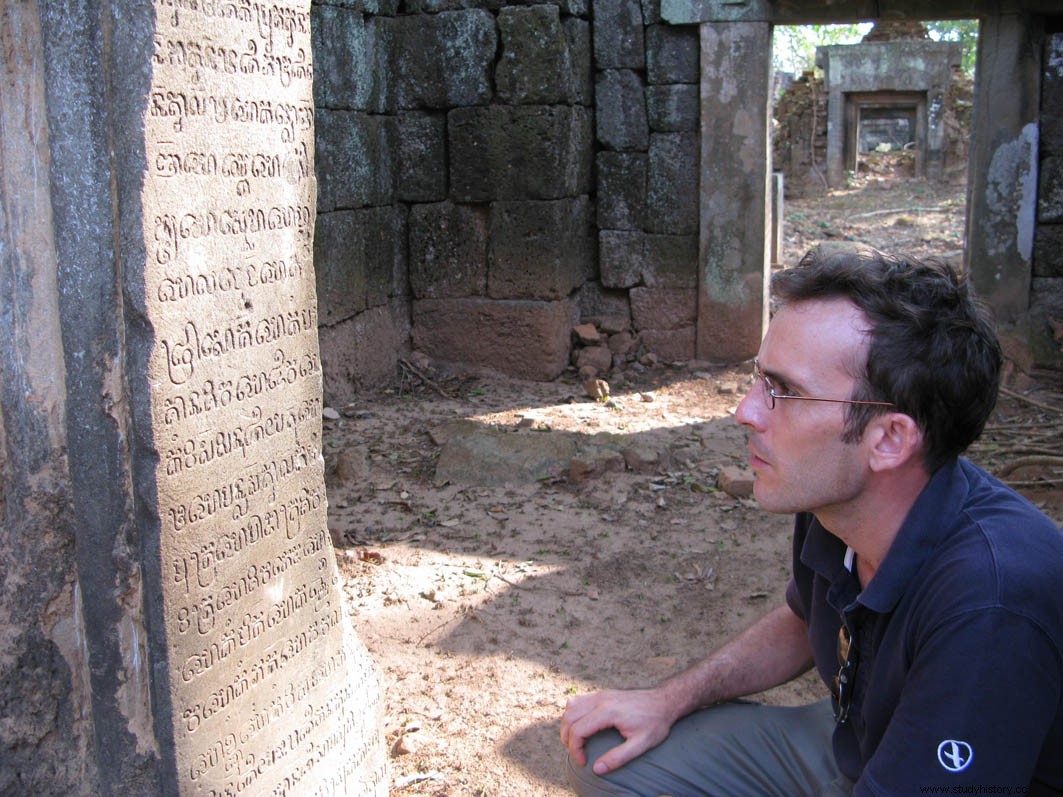
Archaeologist and epigraphist Eric Bourdonneau (EFEO), in front of an inscription on the Koh Ker site.
© Anne-Laure Porée
Finding these works therefore constitutes a large part of your current research?
Indeed, we began by reconstructing the iconographic program of the sculpted groups that have disappeared from the two main temples of Koh Ker*, identifying one by one the characters or deities who made them up. Then, we determined the moment when these statues had been stolen to search for them in the public and private collections where they could have ended up. Investigations are still ongoing.
"Contrary to what the general public imagines, it was not during the terrible period of the Khmer Rouge regime that the greatest looting was committed"
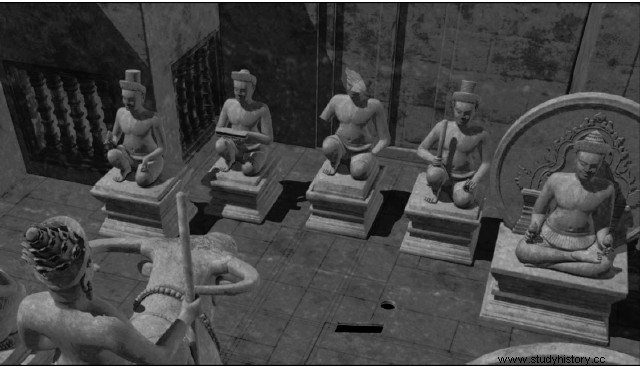
Site of Koh Ker:3D rendering of a group of sculptures that have disappeared. © EFEO
What did you discover during this real detective work?
Contrary to what the general public sometimes imagines, it was not during the terrible period of the "Khmer Rouge" regime (1975-1979) that the greatest looting of heritage took place, but "before" and "after". these tragic times, in the early 1970s, and especially during the 1980s and 1990s. For looting on such a scale to occur, not only is a situation of chaos necessary, but also a certain mobility of men… Under the Khmer Rouge, such mobility was excluded and the country's borders were closed.
Were you able to identify some of the routes taken?
Once out of Cambodia, the sculptures transited through Bangkok (Thailand), to then reach Western Europe, Belgium, or even London (England). At the end of this journey, a large number were then located in private collections or in various North American museums.
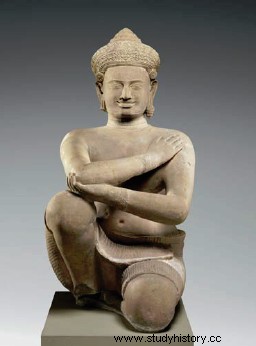
Statue from the site of Koh Ker (Cambodia) found at the Metropolitan Museum of Arts, New York. © Eric Bourdonneau
Have you found any since?
In March 2011, we spotted one of the statues stolen from Koh Ker at an auction at Sotheby's in New York. After a long standoff between the auction house and the New York prosecutor, the work was finally returned to the National Museum of Phnom Penh, at the request of the Cambodian government. Then, in May 2013, we managed to obtain the restitution and therefore the return of two other sculptures. They had been kept at the Metropolitan Museum of Art in New York since the 1990s... An amicable resolution was found with Sotheby's when they agreed to return the statue. The decision to return the MET was "spontaneous".
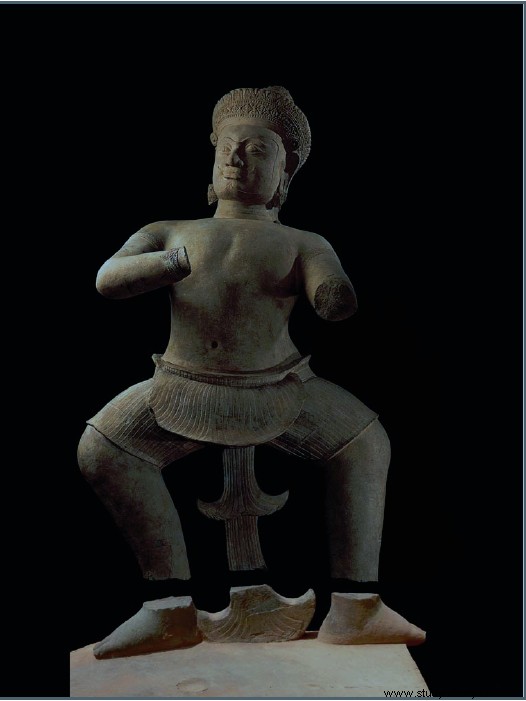
How did you establish the links between the looted statues and their temples of origin?
First, from iconographic studies:given the proven presence of such an epic or divine character within a sculpted program, we could deduce that at his side was necessarily such and such another. And as the statuary of Koh Ker has quite unique stylistic characteristics, there was little hesitation possible in front of works which corresponded by their iconography to the missing pieces of the looted decoration. In addition, we had to deal with statues in the round monoliths with their pedestals:these offering no market value, the looters had chiseled the statues at ankle height, leaving the bases in place. The precise identification of the figures forming these sculpted groups, combined with the examination of the remains remaining in the temples, have made it possible to provide concrete proof of the origin of the works.
How did you use 3D technology to help you with this research?
Virtual reconstructions in 3D allowed us to reintegrate all of the statuary into the architectural program of the sanctuary. They came to underline the iconographic and stylistic coherence of the works by re-establishing their links with the original sites, a link broken by the looters. They undoubtedly contributed to the strength of the demonstration vis-à-vis our interlocutors...
How many of them have been returned to date?
We are in an unprecedented restitution process, which concerns, I repeat, colossal pieces weighing several tons. Cambodia has already been able to obtain the return of seven of these sculptures, previously kept in American museums - in Los Angeles, New York, Denver and Cleveland - or having been offered for sale by Sotheby's and Christie's. They were returned to Cambodia and are now on display at the National Museum in Phnom Penh. The latest, the sculpture of a Rama, was handed over barely three months ago, in March 2016.
Can we say that looting is now less important in Cambodia?
Absolutely. We no longer know the extent of the looting of the 1980s and 1990s, when whole trucks could leave loaded with statues! Even if isolated temples can still be locally victims of thefts of stelae or columns, things have become much more complicated for criminals. The situation of chaos is behind us.
Can the Cambodian experience serve as an example?
It is an interesting experience with regard to what is happening in the Middle East or has happened in Afghanistan. When a country rich in heritage falls into chaos, the art market is very quickly fed by networks that are immediately put in place. In the case of Cambodia, this market has played absolutely no role in safeguarding heritage, contrary to what some collectors sometimes suggest. The statuary of Koh Ker suffered more from this mercantile traffic than from the atrocious regime of the Khmer Rouge.
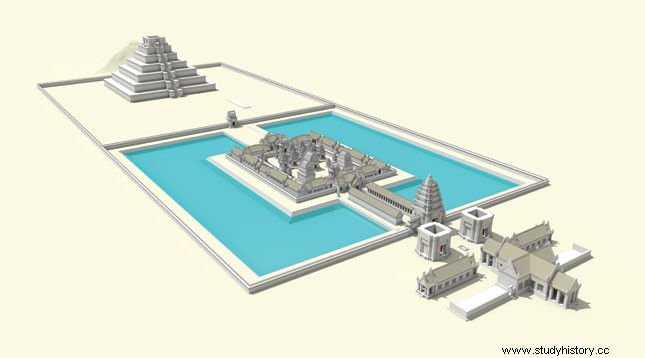
Prasat Thom, one of the temples of the Koh Ker site, being rendered in 3D. ©O.Cunin/Efeo
Koh Ker, former royal city
The archaeological work carried out since 2009 on the site of Koh Ker, in the province of Preah Vihear in Cambodia is carried out in collaboration with the national authority APASARA. In Koh Ker, the former royal city of Chok Gargyar – which for a time eclipsed the grandeur of Angkor – the EFEO's research focuses on two of the site's main temples, Prasat Chen and Prasat Thom. These buildings housed some of the most accomplished sculpted works of Khmer art. Like a colossal "Dancing Shiva" 4 meters high.
The French School of the Far East (EFEO)
Founded in 1900 in Saigon (Ho Chi Minh City) in Vietnam, the prestigious French School of the Far East (EFEO), has as its mission interdisciplinary research on Asian civilizations, from India to Japan. Its 17 research centers, present in 12 Asian countries, allow around forty permanent researchers (archaeologists, anthropologists, linguists, historians, philologists, etc.) to be on these research grounds. The latter animate a vast network of local and international cooperation.
